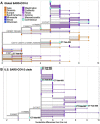This is a preprint.
Coast-to-coast spread of SARS-CoV-2 in the United States revealed by genomic epidemiology
- PMID: 32511630
- PMCID: PMC7276058
- DOI: 10.1101/2020.03.25.20043828
Coast-to-coast spread of SARS-CoV-2 in the United States revealed by genomic epidemiology
Update in
-
Coast-to-Coast Spread of SARS-CoV-2 during the Early Epidemic in the United States.Cell. 2020 May 28;181(5):990-996.e5. doi: 10.1016/j.cell.2020.04.021. Epub 2020 May 7. Cell. 2020. PMID: 32386545 Free PMC article.
Abstract
Since its emergence and detection in Wuhan, China in late 2019, the novel coronavirus SARS-CoV-2 has spread to nearly every country around the world, resulting in hundreds of thousands of infections to date. The virus was first detected in the Pacific Northwest region of the United States in January, 2020, with subsequent COVID-19 outbreaks detected in all 50 states by early March. To uncover the sources of SARS-CoV-2 introductions and patterns of spread within the U.S., we sequenced nine viral genomes from early reported COVID-19 patients in Connecticut. Our phylogenetic analysis places the majority of these genomes with viruses sequenced from Washington state. By coupling our genomic data with domestic and international travel patterns, we show that early SARS-CoV-2 transmission in Connecticut was likely driven by domestic introductions. Moreover, the risk of domestic importation to Connecticut exceeded that of international importation by mid-March regardless of our estimated impacts of federal travel restrictions. This study provides evidence for widespread, sustained transmission of SARS-CoV-2 within the U.S. and highlights the critical need for local surveillance.
Keywords: COVID-19; Coronavirus; Genomic epidemiology; MinION sequencing; Phylogenetics; SARS-CoV-2; Travel Risk.
Figures


References
-
- Centers for Disease Control and Prevention (2020a). First Travel-related Case of 2019 Novel Coronavirus Detected in United States.
-
- Centers for Disease Control and Prevention (2020b). Evaluating and Reporting Persons Under Investigation (PUI) Coronavirus Disease 2019 (COVID-19).
-
- Centers for Disease Control and Prevention (2020c). CDC 2019-Novel Coronavirus (2019-nCoV) Real-Time RT-PCR Diagnostic Panel.
Publication types
Grants and funding
LinkOut - more resources
Full Text Sources
Miscellaneous
